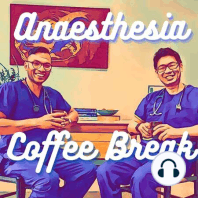22 min listen

How do you PREVENT HYPOXAEMIA when performing a rapid sequence induction (RSI)?
How do you PREVENT HYPOXAEMIA when performing a rapid sequence induction (RSI)?
ratings:
Length:
38 minutes
Released:
Jan 24, 2021
Format:
Podcast episode
Description
You've probably performed a few RSIs in your anaesthesia practice. But have you though about all the techniques you do to make this inherently risky technique safer?In this episode we chat about the approach to the question from the April 2014 and September 2013 SAQ paperDescribe the physiological basis of methods used to prevent hypoxaemia prior to intubation in a rapid sequence induction. Include any adverse effects of these methods. The exam paperhttps://networks.anzca.edu.au/d2l/le/content/7669/Home?itemIdentifier=D2L.LE.Content.ContentObject.ModuleCO-86745Atomic Habits summary by James Clearhttps://www.samuelthomasdavies.com/book-summaries/self-help/atomic-habits/The bookhttps://jamesclear.com/atomic-habitsInterview with James Clear on Making Sense Podcast with Sam Harrishttps://samharris.org/subscriber-extras/200-creatures-habit/Plateau of Latent potentialhttps://i0.wp.com/www.samuelthomasdavies.com/wp-content/uploads/2019/01/The-Plateau-of-Latent-Potential-1.png?w=2000&ssl=1Bleomycin and oxygen toxicityhttps://www.mayoclinicproceedings.org/article/S0025-6196(12)60489-3/fulltextOxygen therapy for sats <94% in acute coronary syndromehttps://www.ncbi.nlm.nih.gov/pmc/articles/PMC4952356/Alveolar gas equation for FiO2 100%FiO2 (Patmos - PH2O) - pCO2/R1.0(760-47) - 40/0.8713 - 50= 663mmHgfor FiO2 at room air of 21%0.21 (713) -50= 99.7mmHg~ 100mmHgCricoid - 20N applied to the cricoid cartilage to cause external pressure constricting the oesophagus and thereby decreasing the chance of aspiration. BUTIncreases the time to intubationImpairs the laryngoscope viewNo proven benefitCan cause discomfortPlease rate, post a review and subscribe!Check out www.anaesthesiacollective.com and sign up to the ABCs of Anaesthesia facebook group https://www.facebook.com/groups/2082807131964430and check out the ABCs of Anaesthesia YouTube channel for more contenthttps://www.youtube.com/c/ABCsofAnaesthesiaAny questions please email Lahiruandstan@gmail.com Disclaimer:The information contained in this podcast is for medical practitioner education only. It is not and will not be relevant for the general public.This contains general information about medical conditions and treatments. The information is not advice and should not be treated as such. The medical information is provided “as is” without any representations or warranties, express or implied. The presenter makes no representations or warranties in relation to the medical information on this video. You must not rely on the information as an alternative to assessing and managing your patient with your treating team and consultant.You should seek your own advice from your medical practitioner in relation to any of the topics discussed in this episode’ Medical information can change rapidly, and the author/s make all reasonable attempts to provide accurate information at the time of filming. There is no guarantee that the information will be accurate at the time of viewing The information provided is within the scope of a specialist anaesthetist (FANZCA) working in Australia. The information presented here does not represent the views of any hospital or ANZCA. These podcasts are solely for training and education of medical practitioners, and are not an advertisement. They were not sponsored and offer no discounts, gifts or other inducements. This disclaimer was created based on a Contractology template available at http://www.contractology.com.
Released:
Jan 24, 2021
Format:
Podcast episode
Titles in the series (67)
The 5 critical effects of pregnancy on respiratory physiology by Anaesthesia Coffee Break